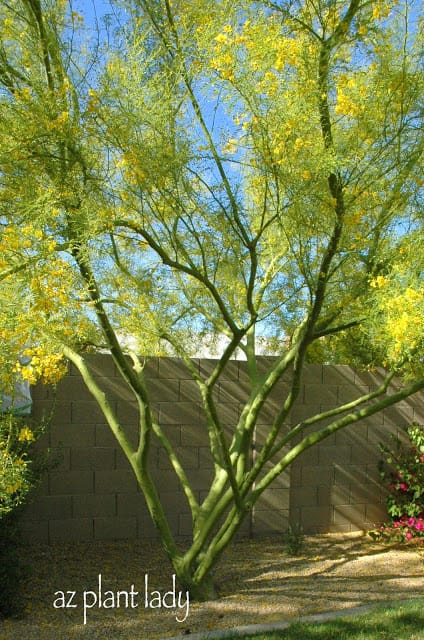
I am faced with a wonderful dilemma of selecting a desert tree…
My last post dealt with the loss of one of our beautiful ‘Desert Museum’ palo verde trees. So now we are faced with the question of which type of tree should we choose to replace the one that I lost? We worked hard the past couple of days to remove the fallen tree and now have a bare space to fill.
I have lived in my home (and garden) for over ten years. As our house was being built, we designed the surrounding garden. I enjoyed deciding which trees I would choose to grace our desert garden with not only beauty but shade in the summer months. I honestly do not understand people who don’t plant trees in the garden – especially in desert climates. They not only provide wonderful shade in the summer months but also add a lot of value to your property.
*This blog contains affiliate links. If you click on a link and make a purchase, I may earn a small commission with no additional cost to you.
Considering Options for Selecting a Desert Tree
I loved my palo verde tree that fell…..I have two others just like it, including the one pictured above. There is much to like about these trees beside the beautiful green trunks – they are fast growing, thornless, evergreen and yellow flowers in the spring. The only drawbacks are that there is litter from the fallen flowers in spring, which means that it should not be planted by a pool. The fallen flowers do not bother me at all – I rather enjoy the carpet of yellow.
But, even with all of the wonderful attributes of this tree, I have decided to select another type of tree as it’s the replacement. Why may you ask? Well, because they grow quickly, I do have to prune them quite a bit. I do not mind pruning, but pruning three of these trees each year was becoming much more of a chore.
Another reason is that in addition to being a horticulturist, I am also a certified arborist and I do love trees and have grown many different kinds in the landscapes that I managed. Right now, I have 14 trees (8 different types) growing in my front, back and side gardens. I would enjoy adding another kind of tree to my plant palette.
So, here comes the fun part…which one to choose?
Selecting a Desert Tree Variety:
Desert Fern (Lysiloma thornberi)
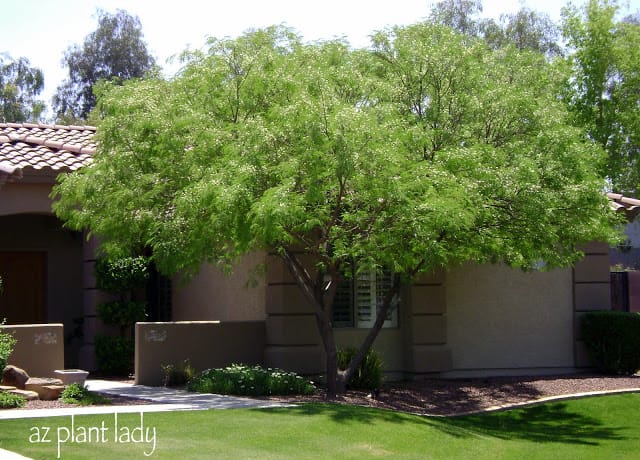
Desert Fern (Lysiloma thornberi, Lysiloma watsonii var. thornberi, Lysiloma microphylla var. thornberi)
One of my favorite things about the desert fern is the beautiful, fern-like leaves – hence its common name.
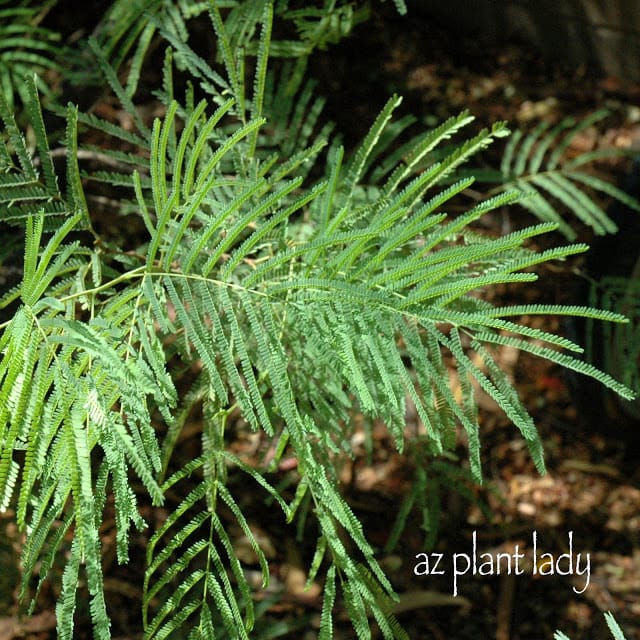
Another plus is that is a native, desert tree and is thornless. The leaves turn a slight maroon color in the winter in our zone 8b climate. In colder winters the leaves may drop altogether. Although what I would call a medium sized tree, it typically grows from 15 – 45 feet high and wide.
One drawback is that it does produce brown seed pods, which some people do not like, but I have no problem with them at all.
*I do have a desert fern tree already, and although another one would look great in my newly bare area, I think I will try to choose a different type of tree.
Sweet Acacia (Acacia farnesiana, Acacia smallii)
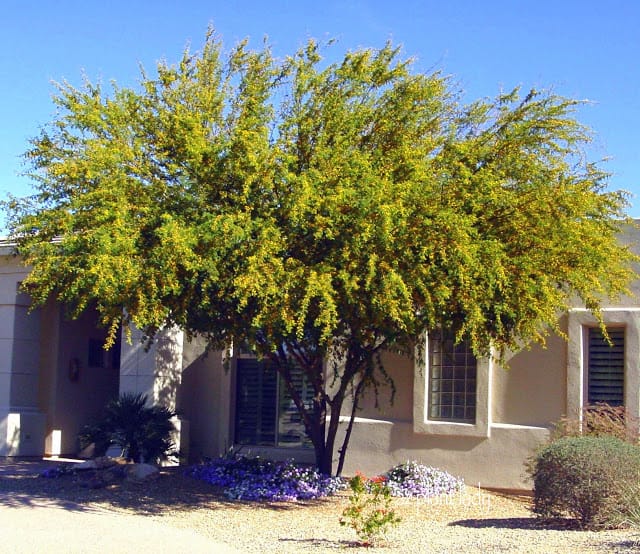
Sweet Acacia(Acacia farnesiana, Acacia smallii)
In the springtime, air is perfumed with the fragrance of the bright yellow puffball flowers of the sweet acacia. When not in flower, the tiny, dark green leaves are easier to see.
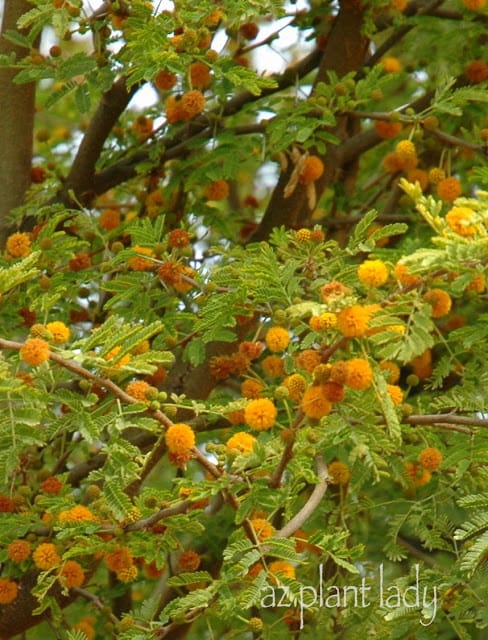
Although found in other areas of the United States, it is also native to the southwest. The mature size is approximately 25 feet high and wide. In areas with mild winters, the leaves will remain on the tree. Dark brown seedpods are produced once flowering has finished.
Some drawbacks to consider are the thorns having to be careful when pruning is necessary (requiring gloves and long sleeves). Now, I am more of a “Do as I say” person rather than a “Do as I do” person. I always wear gloves when I prune, but I rarely wear long sleeves in the summer months. As a result, I have some small scratch scars on my forearms from pruning sweet acacia in the past.
Although I love the beauty, size and the springtime fragrance of this tree, I don’t think I want to accrue any more scars on my arms 😉
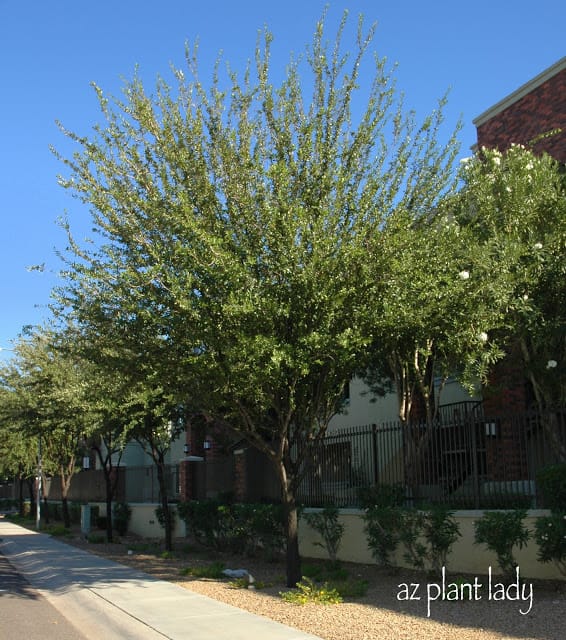
Southern Live Oak (Quercus virginiana)
Southern Live Oak (Quercus virginiana)
Believe it or not, oak trees do very well in our desert climate. Southern live oak, cork oak, and holly oak are all found in the suburban landscape. Southern live oak is the most prevalent, however.
There is little not to love about these trees – they are thornless, have evergreen foliage, are tolerant of full and reflected sun making this tree very low-maintenance. In non-desert climates, they can reach heights of up to 40 – 60 ft., but will not grow that large in the desert. In the landscape areas that I managed, they were a favorite because there was so little maintenance required.

I may be crazy, but this tree seems a little boring to me. Not sure exactly what it is. I spent my teenage years growing up in the town of Thousand Oaks, California and the hillsides are dotted with large, specimen oak trees. The oak trees that I see growing in our area do not resemble the ones from my childhood, so maybe that is the reason that I do not have any in my garden. But, I would wholeheartedly recommend this tree to anyone who wants a lovely, low-maintenance tree.
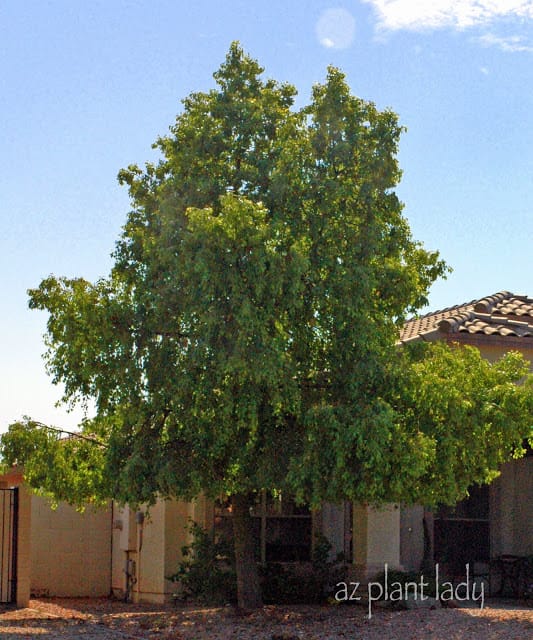
Bottle Tree (Brachychiton populneus)
Bottle Tree (Brachychiton populneus)
Some of you may be surprised to know that many of our trees and shrubs are grown in our arid climate are native to Australia. The bottle tree is one of them. First of all, I love the shape of the leaves and how the sun reflects off of them in a gentle breeze. I also like the slightly pendulous way that the branches hang down. Evergreen in areas with mild winters and a smooth trunk make it an asset in the garden. Its mature size of 30 – 45 feet high and 30 feet wide, makes it suitable for narrower spaces.
As a child, growing up in Los Angeles, we had one in our front garden. My sister and I used to pretend that the little flowers were ‘fairy caps’ and the flowers were soon followed by large, brown seedpods.
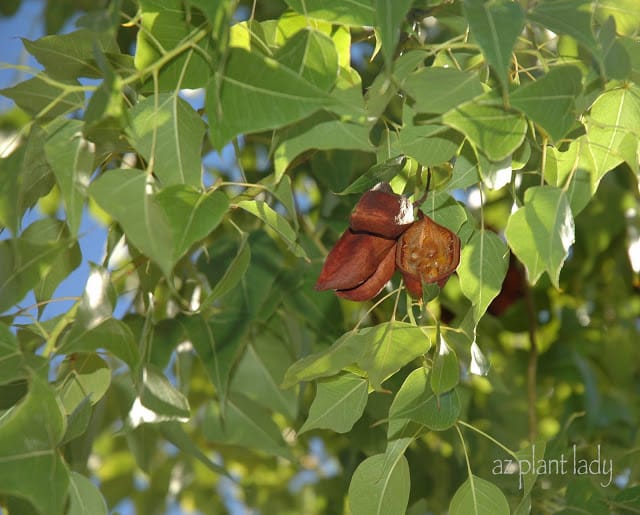
The pods themselves are quite cool looking, and my mother would use them in making wreaths out of seedpods. But what I most remember about the seedpods is getting some of the ‘fuzz’ from the inside stuck on my bare feet, and it hurt. I think that is maybe why I do not have this tree in my garden. But, many people I know who have a bottle tree love them.
**One note of caution, this tree is quite susceptible to Texas (Cotton) root rot (a fungal disease that infects the roots). So if you know of cases of Texas root rot in your neighborhood, I would advise growing another type of tree.
Palo Blanco (Acacia willardiana)
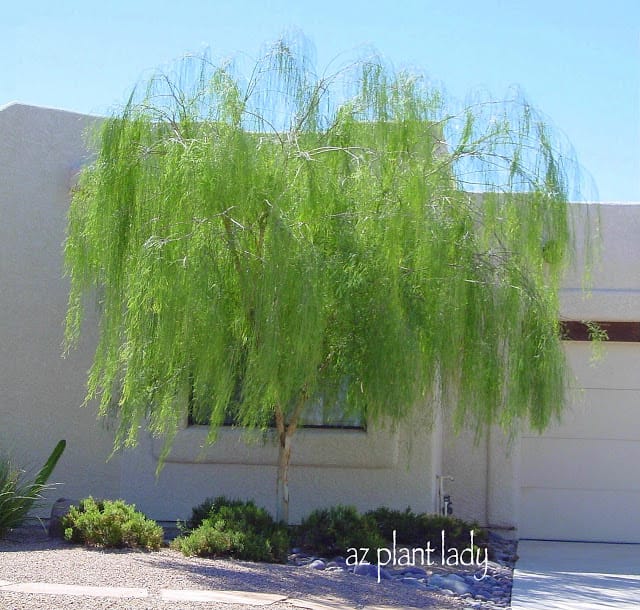
Palo Blanco (Acacia willardiana)
If you have not already noticed already, I am somewhat biased about certain types of trees. This one is one of my favorite smaller trees. The word ‘palo blanco; means “white stick” in Spanish and refers to the white trunk of this tree – considered to be one of its most attractive assets.
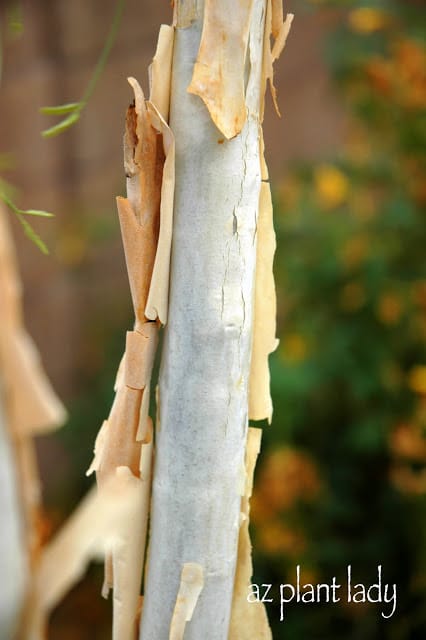
The bark peels off in papery sheets. Palo blanco trees look great when planted near each other in groups of 3 or 5 where their distinctive tree trunks can be shown off.
I also like the bright green foliage of the trees and their tiny leaflets. In winter, the leaves do fall from the desert native, but they are so small and do not create much litter.
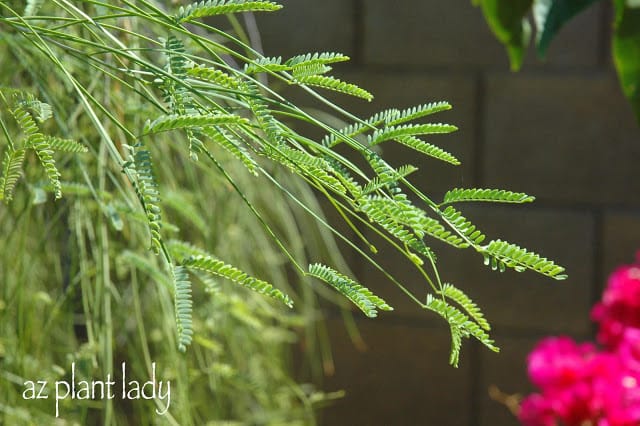
When mature, it reaches a height of 15 – 20 feet and spreads to 10 feet wide which makes it suitable for a patio tree or other small area. Maintenance is minimal, only requiring a small amount of pruning.
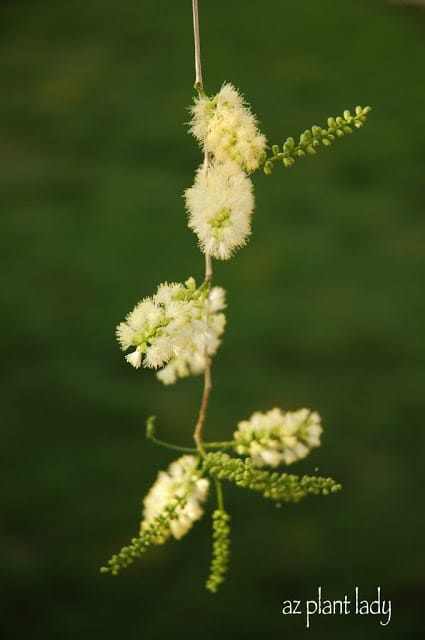
Tiny flowers grace the tree in spring, followed by decorative seed pods.
I like these trees so much that I have three of them. They are growing against my west-facing garden wall and do great in the reflected sun. But, I will probably choose something else for my bare area since I would like a tree that is a little larger for that area.
Indian Rosewood / Sissoo (Dalbergia sissoo)
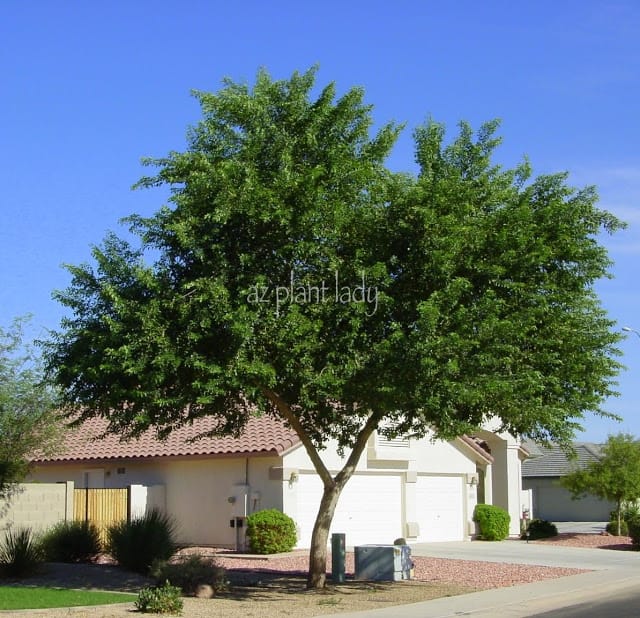
Indian Rosewood / Sissoo (Dalbergia sissoo)
It’s hard to beat the sissoo tree for fast growth and shade. However, they ARE NOT recommended for average size residential landscapes. The photo of the tree above was taken four years after it was planted from a 15-gallon container and it rapidly grew even larger – soon, it had to be removed due to its invasive roots. This tree made its debut in the Phoenix area about 15 years ago and rapidly became quite popular for its lush green beauty.
As sissoo trees have been grown in the southwest landscape for several years, problems have begun to crop up. They have invasive root systems that cause problems with sidewalks, patio decks, pools, and block walls. Also, their mature size is so big that they dwarf the landscapes they have been planted in. Shallow watering often causes the roots to grow along the surface.
Sissoo trees are best used in large outdoor areas such as parks.
Olive (Olea europaea)
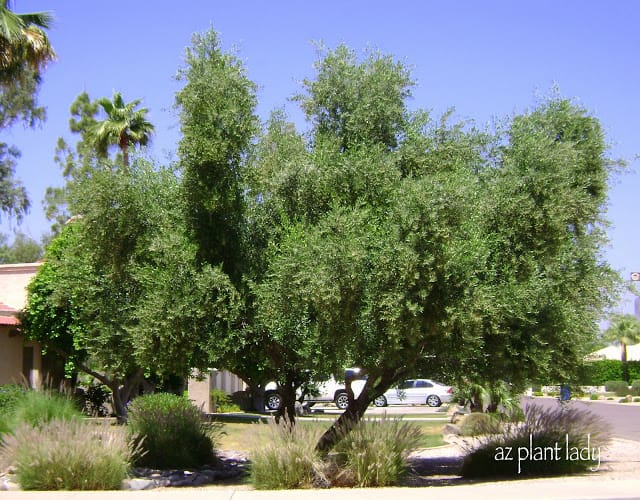
Olive (Olea europaea)
As an option, olive trees work well. Most are multi-trunk with beautiful olive green leaves. They are evergreen and thornless. Regular fruiting olives are no longer sold in many cities due to their highly allergenic pollen. Thankfully, there is a non-fruiting cultivar called ‘Swan Hill Olives’® which is available.
Reaching a mature size of 20 – 30 feet high and wide, olive trees make excellent shade trees and are slow-growing. Some olive trees have fallen prey to some creative pruning (see photo below).
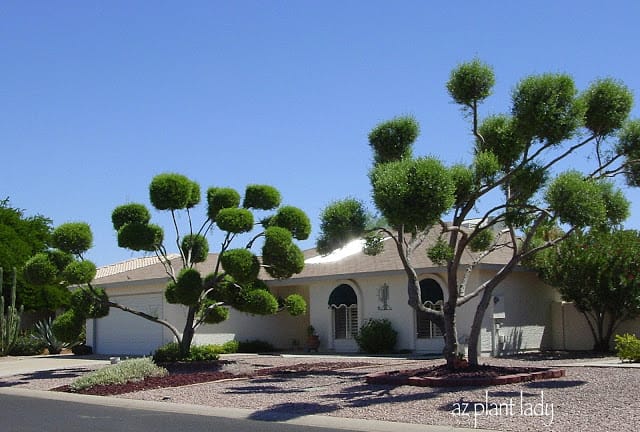
Definitely memorable, but not quite my taste. I would like a tree that will not take too long to grow, so let’s press on to other trees.
Texas Ebony (Ebenopsis/Pithecellobium flexicaule)
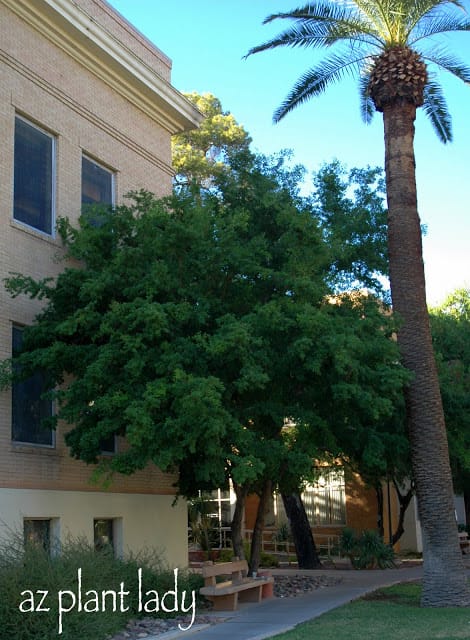
Beautiful Texas Ebony (Ebenopsis/Pithecellobium flexicaule)
An excellent choice is Texas ebony. Particularly for those who like a dense, dark green canopy of leaves. Native to both Texas and Mexico, this tree does very well in the Arizona desert. Everything about this tree is dark – the green leaves the dark brown trunk.
This evergreen tree, has thorns and large brown seedpods. Texas ebony grows slowly to about 15 – 30 feet high and 15 – 20 feet wide.
This is a favorite tree with my clients, but again, I am looking for a tree that grows more quickly.
Chinese Pistache (Pistacia chinensis)
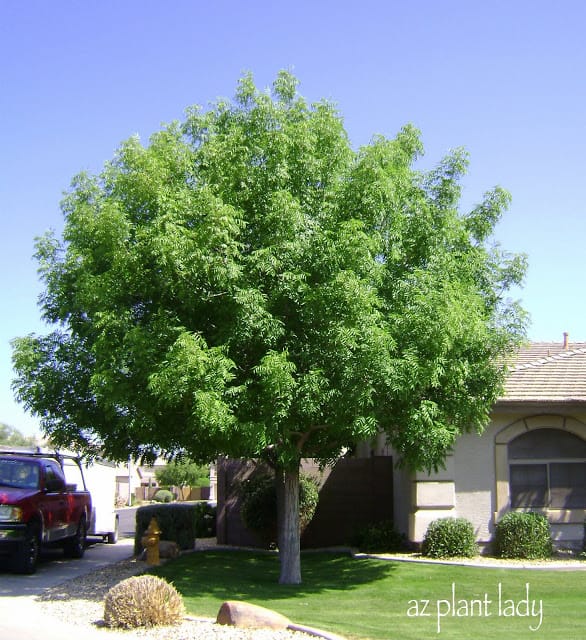
Chinese Pistache (Pistacia chinensis)
An excellent tree for those who like lush, green trees that lose their leaves in winter. Chinese pistache grows to 25 – 25 feet high and wide and has some welcome surprises. It is a deciduous tree known for its stunning fall foliage. Native to China, this tree has become popular in various regions due to its vibrant red, orange, and yellow leaves during autumn. Its small, round fruits are enjoyed by birds.
Chinese Pistache trees are also valued for their drought tolerance and adaptability to different soil types, making them a favored choice for landscaping and urban environments.
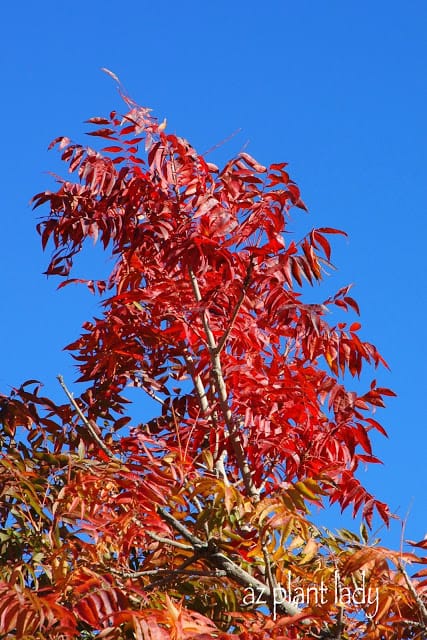
It is one of the few trees in our area that produces a rich fall color. Female trees produce clusters of little berries in the fall.
I like this tree, but I want to see more trees before I decide…..
Cascalote (Caesalpinia cacalaco)
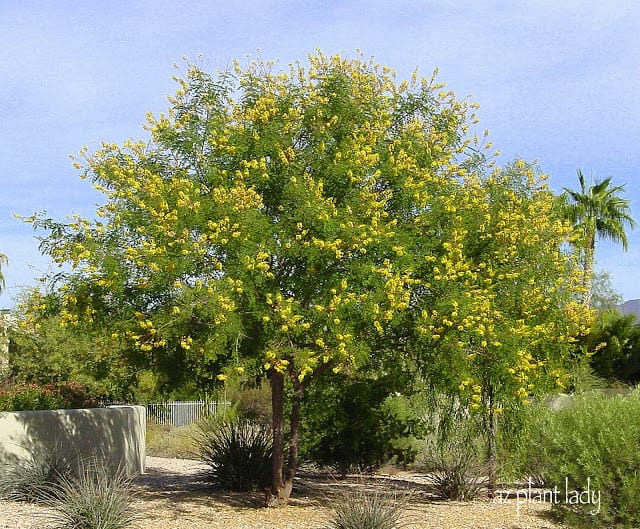
Cascalote (Caesalpinia cacalaco)
Another tree that also provides beautiful color in fall and winter is the cascalote. Plumes of yellow flowers start to appear in November and stay through December. At maturity, they reach approximately 15 feet tall and wide.
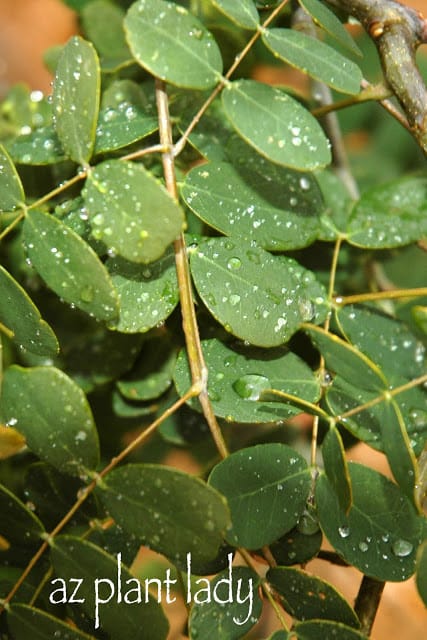
I love the clusters of small round leaves that are evergreen.
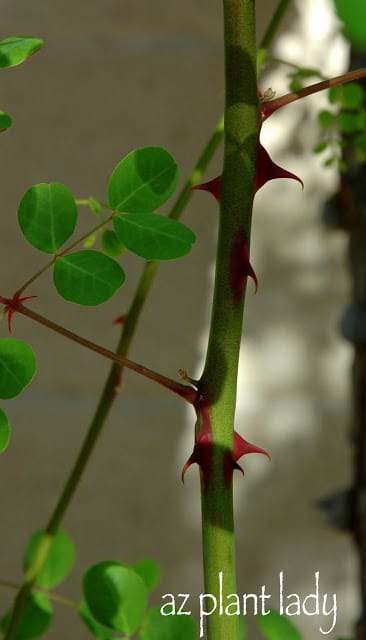
Now I am not a fan of thorns, but the thorns on this tree are almost pretty. You need to plant this tree away from pedestrian areas due to the thorns. You can remove the thorns if you like, which is what I have done in the past. However, there is now a thornless variety, called ‘Smoothie.’
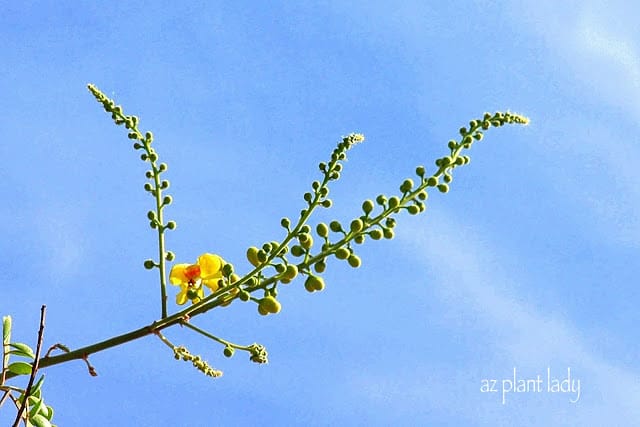
The first flowers of the season begin to open. I bought my first one on a field trip with my Plant Identification college class to the Boyce Thompson Arboretum. I brought it home and planted it in a container because we were renting a house at the time, waiting for our new home to be built. Later, I planted it in our front garden, and I look forward to the beautiful yellow flowers in the fall.
Aleppo Pine (Pinus halepensis)
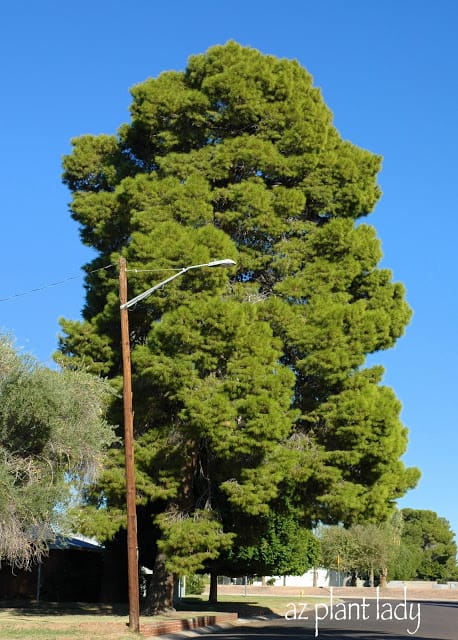
Aleppo Pine (Pinus halepensis)
Believe it or not, some pine trees also do well in the desert. I love the sound of the wind as it blows through pine trees. Aleppo, Canary Island (Pinus canariensis) and mondel pines (Pinus eldarica) are all found in suburban areas of the lower desert areas of the southwest.
Depending on the species, they grow anywhere from 30 – 60 feet tall and most should not be planted in a residential landscape unless there is ample room for growth. They can suffer from soils and water with high amounts of salts.
Pine trees offer heavy shade that will prevent most grasses from growing underneath. Pine needles litter the ground as well. But did you know that pine needles make an excellent mulch? As they break down, they help to acidify our alkaline soils. And so, if you have a neighbor with pine trees, offer to rake some pine needles up to put in your garden. Your neighbor will be so happy 🙂
I am pretty sure that I will not plant a pine tree because I have memories of many hours spent nursing along many pine trees growing on golf courses that were irrigated with reclaimed water. Most of the pine trees did not do well with the high level of salts in the effluent water.
Desert Willow (Chilopsis linearis)
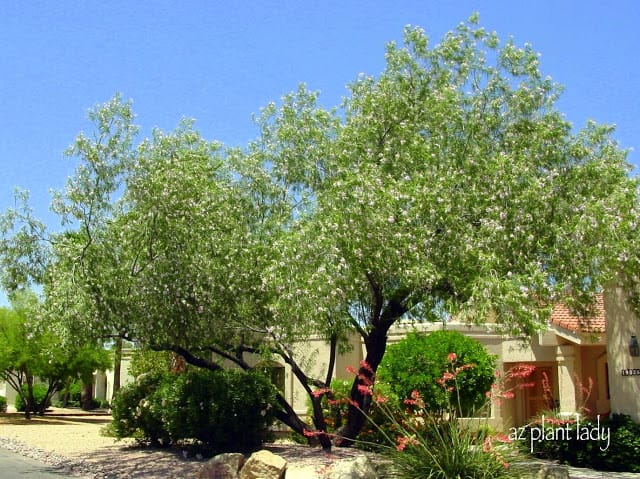
Desert Willow (Chilopsis linearis)
A summer favorite is the desert willow tree. Beautiful, willow-shaped leaves and flowers brighten up the summer garden. It can grow anywhere from 8 – 30 feet high and wide. Available in both single and multi-trunk, I prefer the beauty of the multi-trunk shape.
You will find this tree growing in parks, roadside plantings as well as in residential landscapes. Its small-medium size makes it suitable for smaller areas. It does lose its leaves in winter and forms narrow seed capsules. While not the prettiest tree in winter, the flowers produced spring through fall make it more than worth it and there are new (almost seedless) varieties such as ‘Bubba’ and ‘Timeless Beauty’ that produce little to no seedpods.
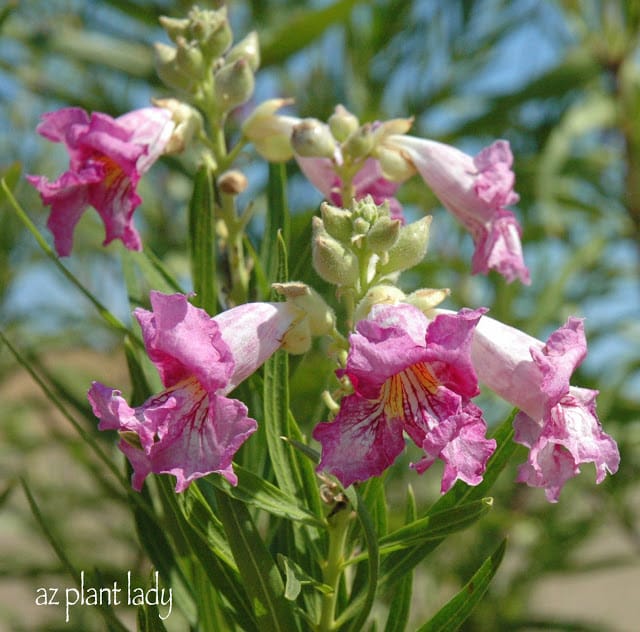
That is why I have four currently growing in my garden. They are simply lovely.
I would still like to find something different, that I do not currently have growing in my garden.
I need to continue looking at possible tree choices. (You can check out my second post of possible tree selections, here 🙂
P.S. Do you have more questions about choosing a tree for your landscape? I share my experience as a horticulturist and certified arborist and profile my top 20 along with all of their characteristics in my mini-course “How to Select the Right Tree for Your Desert Garden”.







